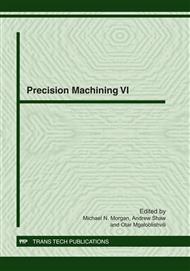[1]
O.W. Boston, W.W. Gilbert. The torque and thrust of small drills operating in various metals. Trans. ASME, Part 2, 1936, 58, 79-89. (1936)
DOI: 10.1115/1.4020128
Google Scholar
[2]
B.K. Hinds, M. Treanor. Drilling of printed circuit boards: factors limiting the use of smaller drill sizes[J]. Proceedings of the Institution of Mechanical Engineers Part B-Journal of Engineering Manufacture. 214(1): 35-45. (2000)
DOI: 10.1243/0954405001517423
Google Scholar
[3]
I. El-Sonbaty, U.A. Khashaba, T. Machaly. Factors affecting the machinability of GFR/eposy composites[J]. Composite Structures 63 329-338. (2004)
DOI: 10.1016/s0263-8223(03)00181-8
Google Scholar
[4]
K. Ogawa, E. Aoyama, H. Inoue, T. Hirogaki, H. Nobe,Y. Kitahara, T. Katayama, M. Gunjima. Investigation on cutting mechanism in small diameter drilling for GFRP (thrust force and surface roughness at drilled hole wall) [J].Composite Structures Vol. 38, No. 1-4, pp.343-350. (1997)
DOI: 10.1016/s0263-8223(97)00069-x
Google Scholar
[5]
J. Paulo Davim, Pedro Reis, C. Conceicão António. Experimental study of drilling glass fiber reinforced plastics (GFRP) manufactured by hand lay-up[J]. Composites Science and Technology 64 289–297. (2004)
DOI: 10.1016/s0266-3538(03)00253-7
Google Scholar
[6]
A.M. Abrão, J.C. Campos Rubio, P.E. Faria, J.P. Davim. The effect of cutting tool geometry on thrust force and delamination when drilling glass fibre reinforced plastic composite[J]. Materials and Design 29 508–513. (2008)
DOI: 10.1016/j.matdes.2007.01.016
Google Scholar
[7]
Youichi Daikoh, Takao Terabayashi, Masami Masuda. Micro Drilling of Printed Circuit Boards (1st Report) - Cutting Force and Chip Flow Mechanism[J]. The Japan Society for Precision Engineering, Vol. 60, No. 12. (In Japanese) (1994)
DOI: 10.2493/jjspe.60.1796
Google Scholar
[8]
N.S. Mohan, A. Ramachandra, S.M. Kulkarni. Influence of process parameters on cutting force and torque during drilling of glass–fiber polyester reinforced composites[J].Composite Structures 71 407–413. (2005)
DOI: 10.1016/j.compstruct.2005.09.039
Google Scholar
[9]
L. J. Zheng, C. Y. Wang, L. Y. Fu, Y. X. Song, L.P. Yang. Wear mechanism of micro-drills during dry high speed drilling of PCB. To be published. (2011)
Google Scholar
[10]
http://www.uniontool.co.jp/english/tech_02-02.html.
Google Scholar


